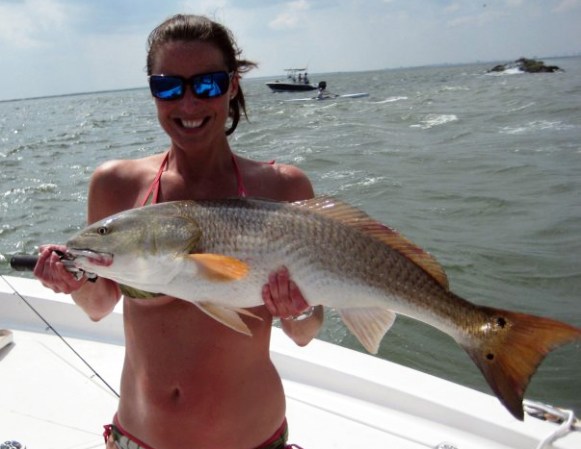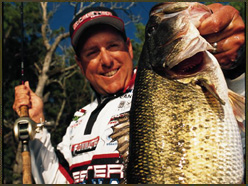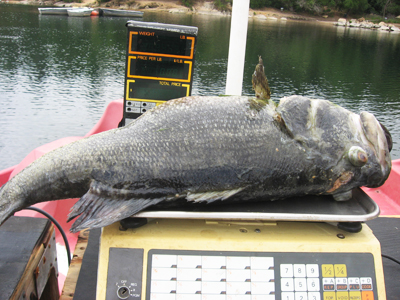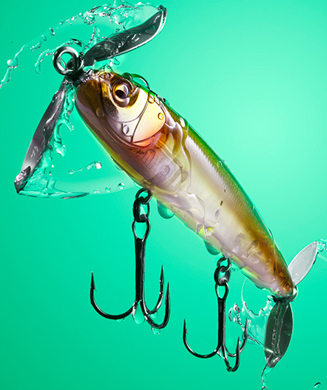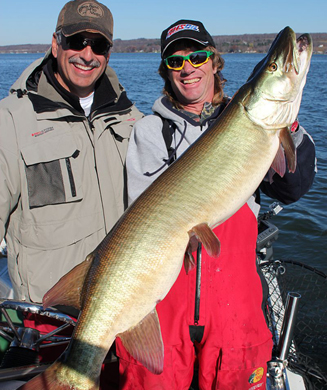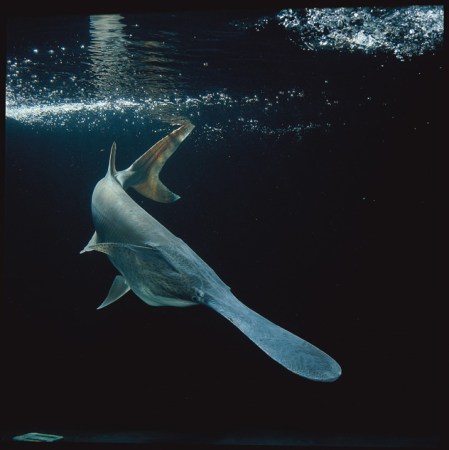Bass anglers have learned that it’s much easier to pattern their quarry when the fish settle into an area for an extended period. Still, there are two seasons of the year when the fish they pursue really go on the move: spring and fall.
Figuring out what’s happening with bass in early spring is relatively simple; it’s spawning season and the fish are coming out of their deep-water winter haunts and moving shallow to find appropriate habitat for reproduction.
After the spawn, bass generally drift back out toward deeper water, where they spend the summer, their home territories largely determined by the available food supply. Bass and anglers alike get in their respective grooves and all is well for a while.
Then cooler weather shows up and everything starts to go haywire for fishermen — sometimes in a hurry — and all of a sudden fall bass fishing is upon them. In many lakes above the Mason-Dixon line, what is generally termed “fall turnover” occurs. This is a weather-induced phenomenon that takes place as cooling surface water displaces the warmer water below and causes fish to move in response. Anglers, too, have to move, changing their fishing approaches to contend with the seasonal shift.
When fall turnover occurs in a lake, the thermocline that separates the warm, nutrient-rich water above from cold, sterile water below dissipates, and dissolved oxygen becomes more prevalent. Because of the change to their environment, fish that had hovered at the mid-depth thermocline during the summer disperse over a wider area, much the same as they do when spring floods cause a lake to range outside its banks temporarily. Understanding the implications of the fall turnover is the first lesson fishermen must learn.
How it all stacks up
Bass are prisoners of their environment; they can’t modify it or escape it. Fish have to move or adjust to radical changes that affect their ability to survive. When bass aren’t concerned about spawning, or getting enough dissolved oxygen to live, they’re looking for their next meal. It’s mainly a bass’s need for food that gets its fins in gear again as autumn progresses.
Changes in water conditions’ temperature, nutrient content and the concentration of oxygen’ displace baitfish and prod predators into following them. The transformation is often incremental but can sometimes be dramatic. Bass patterns that had been consistent for days or even weeks, might suddenly fail to produce.
Hal Schramm, a biologist and bass fisherman who runs the fisheries division of the Cooperative Extension Service at Mississippi State University in Starkville, says that the biggest difference between fishing in summer and fall is that, in the summer, anglers know they have to fish above the ther-mocline to find fish. Below the thermocline, the water is older and generally devoid of dissolved oxygen, making it inhospitable to fish. Most (but not all) lakes stratify; bigger, deeper lakes tend to stratify to greater depths than smaller, shallower lakes.
The thermocline boundary prevents water from mixing from top to bottom. But as the water cools in the fall, and autumn winds agitate the surface, the water on top becomes denser and begins to sink, which causes the entire lake to mix from top to bottom, or turn over.
“Now the fish have the entire water volume to occupy,” Schramm explains. Consequently, finding fish becomes a problem, as does getting their attention. Often the newly mixed water has a lower oxygen content, which tends to make fish sluggish and put them off their feed.
The first move an angler should make is to fish the shallows, says Schramm. Shallower water warms more easily, holding oxygen‚ and therefore baitfish and bass‚ better during the heat of an Indian summer day. In addition, wave action oxygenates the surface water better than deeper water.
Mark Zona, who hosts the Bass Insider television program on ESPN Outdoors, agrees with Schramm. “To me, what ends up happening in the fall more than anything else is that the whole smorgasbord‚ bluegills, minnows, perch‚ end to move up on the flats,” Zona says. “Watch the panfishermen for clues. When the lake starts turning over, they go shallow.”
Different Reactions
Not all lakes undergo fall turnover. Bass guide Frank Campbell believes that the continuously moving water on the Great Lakes and connecting waters around Buffalo, N.Y., where he guides, prevents turnover most years. In fact, Lake Ontario is more apt to turn over in the summer when high winds blow colder midlake water toward shore.
According to Campbell, the fish will seek out a comfort zone, which often causes them to suspend in the upper reaches of the water column or in feeder streams where current stabilizes the temperature.
“One good place to start looking for bass in a lake where a turnover has occurred is at river mouths or any place with a harbor that has a creek flowing into it,” he says. “That’s when you might find all the bass from a ten-square-mile area bunched up in one square mile.”
But a turnover will empty areas of bass, too, he adds. “There will be places where you’ve consistently caught bass all summer and then, boom, all of a sudden there are no fish there,” says Campbell.
John Bondy, an Ontario bass pro with a degree in fisheries management, agrees. Bondy says moving water tends to be more evenly oxygenated and uniform in temperature, making it less susceptible to weather changes. Bondy fishes shallow water far into autumn and says riverine bass will stay near the banks until the water starts turning to slush and it becomes impossible to fish.
When bass are stacked
As noted, lake bass might move anywhere in the water column after the fall turnover occurs, especially if they’re feeding on roaming bait such as shad or alewives. Often the fish will be near the surface, where midday sunshine can warm the water considerably. At times like those, Zona keeps three baits rigged to get on the bite in a hurry’ something to fish on top, on the bottom and in between.
“One day you can just mash the bass on the bottom and the next day you can crush them on top,” Zona says. “The key is to find out where in the water column the baitfish are. I’m not generally a bait-chaser, but at that time of year, I’m really on it.”
Zona says the only way to find the fish is to fish top to bottom. His favorite method is to swim a grub, starting it near the top and counting the bait down until he begins to detect strikes. Even bites from panfish such as perch or bluegills will let an angler know the right depth. “You have to experiment to find the level where most fish are,” he says. “You’ve got to cover the entire water column.”
As fall changes into winter, the coldest water is at the surface, where the ice will begin to form. Fish move deeper again to stay below it and settle in water with the highest level of dissolved oxygen. Consequently, one of Zona’s favorite transition-zone tactics is to fish the outside edge of weed beds, which often are found in the same places he catches fish during the summer months. Bondy agrees with Zona’s strategy, though he says anglers have to adjust to the particular characteristics of the lake.
Wide-open lakes where the wind can mix the water stabilize the quickest, he says. “If you’re on a mountain lake surrounded by tall trees protected from the wind, it’s going to take longer to re-oxygenate and become a good fall fishery. Every lake has its own quirks. In some lakes the fish might move to twelve feet and in some lakes they might stay at forty feet. Wherever they are, by late fall those fish are as deep as they’re going to get. I’ve caught them in sixty feet of water in South Carolina and Georgia during the turnover.”
**
Four patterns to try**
What’s the best approach for autumn bass fishermen to take on their home waters? We asked four noted bass anglers for their favorite fall patterns. These approaches should work anywhere cool weather affects the movements and feeding habits of bass.
1. Drag tube baits at channel bends
For Michigan pro Kim Stricker, the best smallmouth fishing of the year takes place in the late fall. “When the water gets real cold and I’m talking surface temperatures in the upper forties’ it’s prime time for giant smallmouths,” Stricker says. “Better yet, that’s when you can find a lot of big fish in one little spot.”
The approach: Stricker prefers to fish steep breaks such as channel turns (A), especially if they’ve got rocks or wood associated with them.
Tackle choice: A Shubert’s Right Bite tube (cinnamon green or watermelon with purple and gold flake) teamed with a 3/8-ounce rattling jighead is Stricker’s killer bait. He fishes tubes with a 61‚ÅÑ2-foot medium-heavy-action spinning rod, a Quantum Energy reel and 8-pound-test Vanish fluorocarbon line.
Professional secret: The trick here is to leave the bait in place for as long as possible and move it so slowly that it barely moves. “Let it sit,” says Stricker. “Crayfish aren’t all that active when the water starts chilling. Bass don’t expect to see them scurrying along the bottom and consequently won’t be inclined to chase a fast-moving tube.”
******2. Dangle a blade bait along weed lines**

One of TV host Mark Zona’s favorite fall patterns begins after a hard frost. When the water temperature approaches 50, Zona likes to get out past the last line of green grass he can find (B) and work a blade bait along the bottom.
The approach: “Don’t overwork the blade bait,” Zona advises. “It’s not a jigging spoon. It’s more like a plastic worm. Pump it, reel it, pump it, reel it.”
Tackle choice: Zona favors a medium-heavy 7-foot All-Star Rod with a bait-casting reel and 20-pound-test Gamma fluorocarbon line. He fishes a large Silver Buddy blade bait along any changes in the weed line such as inside turns, which is where baitfish congregate.
professional secret: Don’t rear back and set the hook the way you might when fishing a Texas-rigged plastic worm. “You don’t want to swing on the bait when you feel a take,” Zona says. “Just load up and start reeling.”
3. Keep moving until you find fish
Frank Campbell can cast lures with the best of them, but when he’s fishing a big body of water, he often trolls crankbaits to home in on the best spots. “Once you’ve got on a pretty good bunch of fish you can cast and wind, but trolling is the best way to locate bass quickly after a turn-over, says the Buffalo, N.Y., fishing guide. (716-523-0013)
The approach: Campbell trolls short-bodied, deep-diving crankbaits about 200 feet behind his boat (C) in 20 to 30 feet of water.
Tackle choice: A 7-foot medium-action All-Star rod and matching Shakespeare spinning reel with 8-pound-test Shakespeare Supreme Super Tough line. Campbell adds a barrel swivel and short length of fluorocarbon line. The Bomber 5A and 6A crankbaits he favors cover depths of 5 to 12 feet.

Professional secret: If Campbell doesn’t catch bass in the mid-depth waters where smallmouths tend to suspend in fall, he’ll often add weight to the line ahead of the swivel or simply switch to a crankbait that dives deeper, adjusting the depths his lures run incrementally.
4. Don’t give up on topwaters too soon
Veteran bass pro Kevin VanDam is a noted power fisherman who is convinced that the same approach he uses throughout the season can pay big dividends in the fall.
“It’s amazing to me how long bass will stay shallow,” notes the Michigan angler. “Lakes that have a lot of flats extending out from their shorelines will have fish shallow until they freeze over.”
The approach: VanDam recommends staying out from the offshore edges of flats and burning a spinnerbait across them (D).
Tackle choice: A 6-foot 10-inch Quantum KVD spinnerbait rod paired with a Quantum Burner (with a 7:1 retrieve ratio) bait-casting reel and 20-pound-test line. VanDam uses a 1/2-ounce Strike King spinnerbait with two No. 4 willowleaf blades.
Professional secret: “I like the windy side of the lake with flats from two to five feet falling off into six to 10 feet‚ the first drop-off away from the bank,” says VanDam. “Speed is critical. Burn it back and just when it’s going over the drop, stall it‚ just change the rotation of the blades for a second. The bass will knock the rod out of your hand.”

